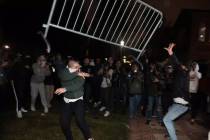Education ratings are low where poor, less-educated live
A 24-pack of stress balls sits in the office of Laure Forsberg, principal of Fitzgerald Elementary School.
The struggling North Las Vegas school now ranks lowest among the Clark County School District’s 337 campuses, according to the recently released results of the state’s fledgling rating system. The school’s score of 24 out of 100 puts it just three points from dead last among all Nevada public schools.
“I’m as concerned as anyone,” said Forsberg, who explained without excuses that landing at the bottom is not as simple as it would seem.
Less than 20 miles from Fitzgerald, which is near Martin Luther King Boulevard and Carey Avenue, sits the highest-ranked traditional public school in the state, Twitchell Elementary School in Henderson. Only the Davidson Academy of Nevada, which serves gifted middle and high school students, and the College of Southern Nevada’s high school campuses can beat it.
Twitchell and Fitzgerald are both neighborhood schools. No magnet program at Twitchell draws the best and brightest from across the Las Vegas Valley.
In addition to distance, the schools are separated by a chasm of circumstances that have more influence on a school’s performance than funding or staffing, according to a Review-Journal analysis. From Fitzgerald to Twitchell, and at all the schools between them, economic and social indicators have a hefty impact on how a school and its students do.
With rare exception, school ratings are higher districtwide when the surrounding neighborhood has a higher median household income and more college-educated residents, regardless of whether parents have degrees.
Schools do progressively worse when their neighborhoods have higher rates of high school-only educated residents, families falling below the poverty line, and minorities.
Clark County’s one-star schools on average serve areas where 32 percent of residents never went beyond high school. In those same areas, just 8 percent of residents are college educated, far short of the county’s overall 22 percent average.
As schools gain stars, the percentage of neighborhood residents with at least a bachelor’s degree also steadily increases to 29 percent on average for five-star schools, more than 3.5 times the rate of college-educated residents for one-star schools.
“We’re blessed to have the components of a good school,” said Sue Abacherli, a 10-year kindergarten teacher at Twitchell, where the student poverty rate is 16 percent, less than a third of the district average.
Caucasian students outnumber Hispanics four to one, which is the exception in the Hispanic-dominated district.
At Twitchell, nine out of 10 students have grade-level math and reading skills.
“But there’s no utopia,” Abacherli said.
SUCCESS FOR ALL?
From Clark County Superintendent Pat Skorkowsky to multiple associate superintendents, none deny the link binding socioeconomics to school performance. The findings come as no surprise, they said.
“It shows that we have a lot of work to do,” said Mike Barton, the district’s chief student achievement officer.
But is the link one that public schools can break?
Barton referenced the famed 1966 Coleman Report, “Equality of Educational Opportunity,” which sampled 650,000 students nationwide.
The 700-page analysis commissioned by the U.S. Department of Education found that student backgrounds have a greater influence on academic performance than school resources, which indicates that spending more on teaching disadvantaged students has little effect on their academic performance.
“As a district, we disagree with that. I disagree with it,” said Barton, while acknowledging that certain schools face greater challenges than others, including homelessness, non-English speaking students and extreme poverty.
But all the external factors can be overcome, he said. A school in a poor, uneducated, minority-dominated neighborhood can achieve the same success as students in an affluent area.
“It can’t be an excuse,” Barton said.
Barton offered as proof Hancock Elementary, near Decatur and Charleston boulevards. The school is a rare example of what Barton would like to see districtwide. More than 90 percent of its students live in poverty. Minority students outnumber Caucasians four to one. But about 85 percent of students were at grade level in math and reading last year, according to 2012-13 state tests.
It’s a school of Fitzgerald students achieving Twitchell success.
Superintendent Skorkowsky said the district must rise above the limitations that drag down achievement for disadvantaged students.
“It takes a long time to get there,” he said, pointing to small successes afforded by investing in prekindergarten and other early-education programs. “I’m optimistic it can be done.”
However, nearly 50 years after the Coleman Report, Clark County schools with the highest concentrations of poverty are spending $110 million a year in federal Title 1 funds to boost student performance. And the link between socioeconomics and schools in the Las Vegas Valley remains strong. The highest-performing schools are in the southwest valley and Henderson, where median household incomes range from $68,000 to $98,000.
The lowest-performing one- and two-star schools are mostly in central Las Vegas and North Las Vegas ZIP codes, where median household incomes average $42,000.
Under federal standards, a four-person household must earn less than $43,568 for children to qualify for reduced-price school meals. The median household income is $25,800 in downtown ZIP code 89101, which includes one-star Cambeiro Elementary School.
High-performing campuses do exist in 89101 — Bracken Elementary School, Cashman Middle School and the Las Vegas Academy — but they are not beating the odds. As magnet schools that attract students from across the county, few neighborhood students attend them.
Fitzgerald serves neighborhood families and receives $14,200 per student in annual funding, almost twice as much as Twitchell’s $7,300. This is an attempt to compensate for Fitzgerald’s twin burdens of poverty and poor performance, yet the less-funded Twitchell stands at the top of the state’s fledgling ranking system.
THE DEMOGRAPHIC DRAG
From the time the morning bell sounds, the differences between Fitzgerald and Twitchell are apparent. Twitchell students begin classes immediately. Fitzgerald students funnel into the cafeteria for breakfast at no charge.
“I know there’s the mindset out there that it’s quote unquote ‘not our job,’ ” Forsberg said of feeding students. “But we control what we can inside the school.”
That includes ensuring students eat.
Teachers use the time to bond with students because at Fitzgerald their duties don’t stop at instruction, she said. As teacher Josephine Corpuz tells her third-graders, “I am your mom here at school.”
The added burden takes its toll on teachers, said Forsberg, not faulting the community or parents who often are struggling to get by.
“Teachers have an awesome responsibility here. It can wear on them,” said the principal who struggles to find experienced teachers when extra work and training are the only incentives she can offer.
The school’s $155,250 in annual Title 1 funds goes to support services to clothe, feed and guide students with the help of a full-time social worker and other extra staff. The school also offers parents GED classes and English and writing classes.
“Teachers honestly choose to be here,” Forsberg said. “They know the challenge.”
Corpuz, a Fitzgerald teacher for nine years, is a rarity at the campus where only about half the teachers return each fall. Forsberg has improved teacher retention in recent years by providing the training to work with students facing so many hardships, but it doesn’t come as easily as at Twitchell.
At Twitchell, Principal Michele Wooldridge posted few teacher openings last spring.
“Teacher applications were a mile long,” she said. “Once people get here, they stay.”
All of Fitzgerald’s student and parent services have one purpose: to let teachers focus on instruction, which is where the difference will be made, Forsberg said. She said that with good teaching, Fitzgerald students can do as well as a those at Twitchell.
“You walk a fine line in a school like this. You try to provide everything, but you can’t lower your expectations,” Forsberg said.
Andre Denson, the district’s chief educational opportunity officer, said it may take longer for disadvantaged students to become proficient, because they often enter school already behind.
“They can get there,” he added. “You have to have the belief coming through the door that all children can learn. Don’t lower the bar for these students and schools.”
But proficiency remains a challenge for at-risk students, something made clear in the district’s 36 traditional high schools, which have an average graduation rate of 61 percent, far below the national average of 78 percent, according to the National Center for Education Statistics.
None of the traditional high schools earned five stars, and only Boulder City, Coronado, Indian Springs and Moapa Valley high schools earned four stars.
At the elementary level, Fitzgerald’s Corpuz was assigned 26 third-graders this fall, and 16 tested a grade level or more behind in basic skills. One of her students can read only three words per minute.
The state’s expectation by year’s end is that students read 100 words per minute to be proficient in third grade.
She has an even higher expectation for them, even though most would have to make leaps to get there: 110 words per minute. It worked last year. More than 80 percent of her students read at grade level at the end of 2012-13.
She credits her persistence to independent reading, making each student read at home for 20 minutes daily. For proof, they must keep a reading log that also shows whether they comprehend what they read.
“Good teachers are good teachers anywhere,” Corpuz said.
But her class’ success, which doubled the school’s average proficiency rate, wasn’t repeated across Fitzgerald.
LACKING LIFE EXPERIENCE
Though separated by their schools’ rankings, Corpuz and Twitchell kindergarten teacher Abacherli do things much the same.
Corpuz sets clear expectations for her Fitzgerald third-graders on day one, explaining what they are doing, will do and why. She splits them into small groups with both high and low performers and then provides individual attention as needed.
Abacherli achieves the same order in her Twitchell kindergarten class by the third week. She, too, must construct it.
“They don’t come in this way. But they can run my room by the first week of October. They want to be empowered.”
She also groups students the same way and identifies those lagging behind.
It’s “not an even playing field,” Abacherli conceded. “You build on what you got. And my students come in with a wealth of experiences.”
But at Fitzgerald, the lack of those kinds of experiences limits students. Many of her students have never left the neighborhood, Forsberg said.
“Without those past experiences, you have to break everything down in small chunks,” she said.
You can’t assume every student has the same basic knowledge.
Some of Abacherli’s students, on the other hand, have been on cruises. Most have traveled, been to the beach.
Fitzgerald offers those experiences as best it can using extra funds provided by its status as a Prime Six school. The district has nine west Las Vegas elementary schools designated Prime Six because of high minority and poverty rates, and it gives them extra support. Fitzgerald children are regularly brought to area attractions, such as the Shark Reef, Springs Preserve and Valley of Fire State Park.
“My kids, more than you think, never get outside,” said Forsberg, recalling a young girl who stepped off the bus during an excursion and exclaimed “Oh my goodness. Look. Mountains.”
All these efforts will pay off, said Forsberg, who is confident Fitzgerald will rise through the ranks. Starting last year, the school also had its first-ever Parent Teacher Association.
On the other hand, Twitchell has the largest PTA of any school in the state with 545 members, about 75 percent of whom come to classes aiding teachers.
“You can move mountains if you have supportive families,” Abacherli said as a mother cut yarn in the back of her Twitchell kindergarten room.
MAGNETS MAKE A DIFFERENCE
Not even a block from Fitzgerald sits another Prime Six school, Mackey Elementary. Same neighborhood. Four-star rating.
But Mackey isn’t beating the odds. The magnet school is changing them.
While neighborhood students attend kindergarten at Mackey, only a quarter of the other students come from the area. The vast majority come from elsewhere in the Las Vegas Valley for the school’s magnet program, Leadership and Global Communication. Neighborhood parents who don’t apply or aren’t accepted at Mackey are assigned to Fitzgerald.
Many of the district’s apparent underdog success stories are magnet schools in poverty-stricken neighborhoods, switched from the traditional structure as a way to desegregate ethnically isolated campuses. Few neighborhood children remain at the schools. But Mackey Principal Kemala Washington said the program does benefit neighborhood students who enroll.
“When children are in a diverse setting, they all excel,” said Washington, who refuses to believe that disadvantaged students are doomed to underperform. “None of us would be in the business if we believed that.”
One disadvantaged school is turning the corner while exclusively serving its neighborhood: Hancock Elementary. Principal Jerre Moore came to the school, near Charleston and Decatur boulevards, in 2010-11. She left Bendorf Elementary School, a nationally recognized blue-ribbon school, in southwest Las Vegas.
“You don’t really know what you’re getting into until you come here,” said the thin, tall principal whose words come out in a Texas twang. “Honestly, I didn’t think scores could be so low.”
When she arrived at Hancock, less than half the students read at grade level. A little over half scored at grade level in math.
Her school faces many of the same challenges as bottom-ranked Fitzgerald. Both have student poverty rates exceeding 90 percent.
Moore also has many of the same mantras as Fitzgerald’s principal: Maintain high expectations for students. Connect with parents. Provide support services. Meet needs for food, clothing and shelter first.
And nurture children. She tells teachers to make positive contact with students at the beginning and end of each day. A high-five, tousle of the hair or hug.
But Hancock has made gains in the past two years. More than 80 percent of its students were at grade level in math and reading last school year, making it a five-star school.
During that time Hancock also received a $1.05 million federal turn-around grant. Moore spent it on iPads for students in grades three through five, a 30-minute extension of the school day and professional development for teachers. She sometimes coaches them herself on how to deal with students coping with poverty, broken homes and homelessness.
“Teachers are thrown in to triage without training,” she said. “They’re not trained as psychologists.”
Next school year, Hancock returns to the ranks of a regular at-risk school, receiving Title 1 funding for poor students but no grant money. That expires after three years. Can Hancock maintain its momentum and be an example for schools struggling to overcome their surroundings?
“I don’t know,” Moore said. “I feel like it’s a battle every day. It’s hard to maintain that intensity. Such an enormous amount of work here.”
In two weeks, the school has doubled the number of students so needy that they receive food-filled backpacks on Fridays, according to counselor Michele Elliott, a 15-year fixture at the school.
She remembers when the neighborhood was high-income in 1998 and the school was a high flyer. But as the neighborhood declined, so did student performance. It’s nice to see a resurgence at school, but students are no better off at home, she said. The student poverty rate remains at 65 percent, about where it was in 2010.
Moore uses the word “hope” often for the future here, well aware of the odds against sustainable success for schools such as Hancock.
Fitzgerald’s Forsberg knows the odds, too. But she is dedicated to Fitzgerald, the district’s lowest-ranked school.
“These kids need stability,” she said, if not at home, then in school. She is confident the school will rise. It just needs to stick to high-level instruction, regardless of the level of the child.
More than that, she plans for Fitzgerald to be “exemplary,” a five-star school.
Is it possible?
“On a step-by-step basis, absolutely,” said Forsberg, in her seventh year at the helm of the struggling school. “I believe children’s lives depend on it.”
Review-Journal Database Editor Brian Haynes contributed to this report. Contact reporter Trevon Milliard at tmilliard@reviewjournal.com or 702-383-0279.
Grading Clark County Schools
Check the rating for each school in the Clark County School District using this interactive map.



























